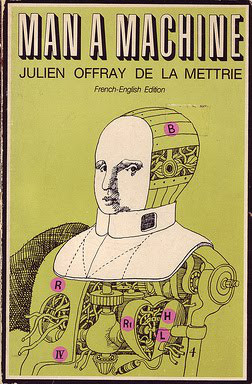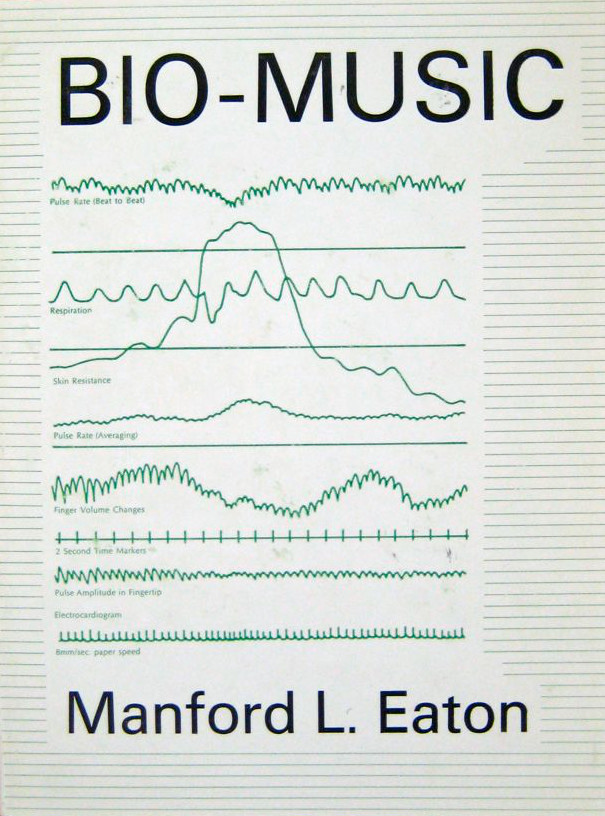Julien Offray de La Mettrie: Man a Machine (1747-) [FR, EN, TR, DE, PL]
Filed under book | Tags: · body, enlightenment, machine, materialism, philosophy

French physician and Enlightenment thinker Julien Offray de La Mettrie (1709–51) was the most uncompromising of the materialists of the eighteenth century, and the provocative title of his work ensured it a succès de scandale in his own time.
“In 1747, La Mettrie wrote a small but powerful book arguing that the soul, the human will, and consciousness were all reducible to bodily processes. According to La Mettrie, ‘The human body is a machine which winds its own springs.’
La Mettrie’s L’homme machine (Man a Machine or Machine Man) was likely completed in August of 1747. The book was controversial, arguing against the traditional notion of soul and suggesting that man was no different than any other animal. This small volume espousing this materialist philosophy was just over one hundred pages long, written in forceful but casual prose. Less than half a year after its publication, the book became the center of controversy and led to La Mettrie’s self-exile from Holland.
The book was printed anonymously and copies were circulating in Holland by December. On December 18th, the publisher—Elie Luzac—was called before the Consistory Church of Leyden and ordered to deliver all copies of the book for burning and to promptly reveal the author. The publisher indeed delivered some copies for burning, but claimed he did not know who had written the piece. The following year, the publisher issued two more printings of the book and then promptly left Holland.
In the meantime, rumors began to circulate that La Mettrie was the author of the book. La Mettrie was not naïve about the potential outcomes of this: he had previously fled his native France after the public burning of his 1745 book The Natural History of the Soul. He therefore fled Holland to Berlin on February 7, 1748, where he came under the protection of Frederick the Great who provided him with sanctuary and a small pension and made him the official court physician. La Mettrie died of food poisoning in Potsdam in 1751.” (from Cathy Faye, “Banned and Burned Books: La Mettrie’s L’homme machine“)
commentary (J.E. Poritzky, 1900, German)
commentary (Paul Carus, 1913, English)
commentary (Ernst Bergmann, 1913, German)
commentary (Ann Thomson, 1996, English)
commentary (Peter Gendolla, 2000, English)
wikipedia (English)
L’homme machine (French, 1774, Archive.org)
L’homme machine (French, 1796, Archive.org)
L’homme machine (French, 1800, Archive.org)
L’homme machine (French, With an Introduction and Notes by J. Assezat, 1865, Archive.org)
L’Homme Machine / Man a Machine (French-English, Trans. and With Notes by Gertrude C. Bussey, revised by M.W. Calkins, 1912, Archive.org)
L’homme machine (French, With an Introduction and Notes by Maurice Solovine, 1921, Archive.org)
İnsan Bir Makine (Turkish, trans. Ehra Bayramoğlu, 1980)
Machine Man (English, trans. Ann Thomson, 1996)
Der Mensch eine Maschine (German, undated)
Człowiek-maszyna (Polish, undated, DJVU)
Louis Armand, Jane Lewty, Andrew Mitchell (eds.): Pornotopias: Image, Desire, Apocalypse (2008)
Filed under book | Tags: · art, body, gender, image, masochism, pornography, sex, sexuality, theory

Bodily existence is an existence lived in constant fascination with a world beyond one’s reach. Embodiment, desire, metaphor. To exist on the verge of nonexistence. In the headlong pursuit of the real, of the other. Of the base materiality of the world, of religious hypothesis, of absolute relativity. Every utopia is a pornography, a recrudescence and pathological disillusionment, a lure into the vortex–paradoxical annulment of pure reason, compulsion, repetition, consumption.
A fact of bodily existence is to know that the body is our most complex and multi-faceted machine in a world of incessant technological progress. The body is a marvel of engineering; it is the outward face of primal nature; it is a disgusting vessel in which to house the soul; it is a primitive device, fragile and disposable. Bodies are re-produced, experimented upon to the limits of their tolerance, dissected and debated to every last cell, mended, prosthetically enhanced, moralised, abused and adored. The interface with the world we live in means that the body is always laid open to scrutiny without ever simply constituting some thing within our grasp: it is the site where violence and metaphysics interchange, technicity and catatonia, the sublime and the grotesque.
The body cannot be neutral or indifferent. Its design is such that it must respond to both exterior challenge and interior impulse. Our means of survival, the sex act, galvanizes the body into a unique state of existence, which, though transient, becomes the essence of being; the concentration of an idea, the heightening of sense, the ultimate dissolution.
How to write this purposeful transformation? How to write this instantaneous, ephemeral shattering of perception? This is the task of pornography. Our project will present the body in its most extreme of forms and behaviour, all of which demonstrate the human attempt to satisfy, and solve, the oft-inchoate needs of our psychology and physicality. We seek papers which deal with pornography as condition, symptom, addiction, spectacle, product, simulacrum. Above all as a fundamentalism embedded in the very structures of representation, knowledge, non-knowledge and the unpresentable.
Contributors include Georges Bataille, Johannes Birringer, Karmen MacKendrick, Benjamin H. Bratton, Lara Portela, Louis Armand, Stewart Home, Jane Lewty, Thierry Tillier, Ruark Lewis, Malwina Zaremba, Darren Tofts, Bonita Rhoads, Stuart Kendall, Ian Haig, Jena Jolissaint, Pierre Daguin, Vadim Erent, Florian Cramer, Beth Lazroe, Andar Nunes.
Publisher Faculty of Philosophy of the Charles University, Prague, December 2008
Litteraria Pragensia Books series
ISBN 9708073082918
272 pages
PDF (69 MB, updated on 2013-5-11)
Comments (4)Manford L. Eaton: Bio-Music (1974)
Filed under book | Tags: · biophysics, body, music, sound

“Bio-Music is the term used by ORCUS Research to describe a class of electronic systems that use biological potentials in feedback loops to induce powerful, predictable, repeatable, physiological/psychological states which can be elegantly controlled in real time. The types of states that can be programmed are as powerful as chemical (drug) states, and the hallucinogenic powers of electronic sensory feedback systems can be controlled and guided with a precision utterly impossible with chemical methods. [..] It is the purpose of this book to provide some guidelines for researchers in this fascinating field and to attempt to prevue the types of systems that are now or soon will be within the state of the electronic art. We hope that this book will be read by those within the arts who hold as their thesis that only through the development of arts as powerful as the technology around us will we ever be able to regain any of the peace and understanding that was ours in a more pristine world.” (from the Preface)
Publisher Something Else Press, Barton/VT, 1974
ISBN 0871101246, 9780871101242
65 pages
Commentary: Branden W. Joseph (Grey Room, 2011).
PDF
See also Eaton’s article Induce and Control: Bio-Music Is Here Today (Music Educators Journal, 1973).

